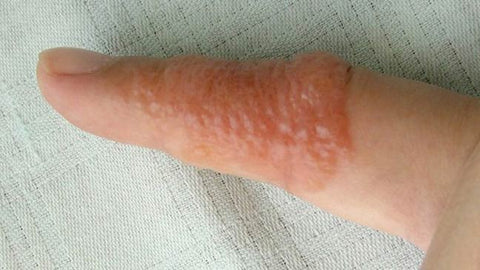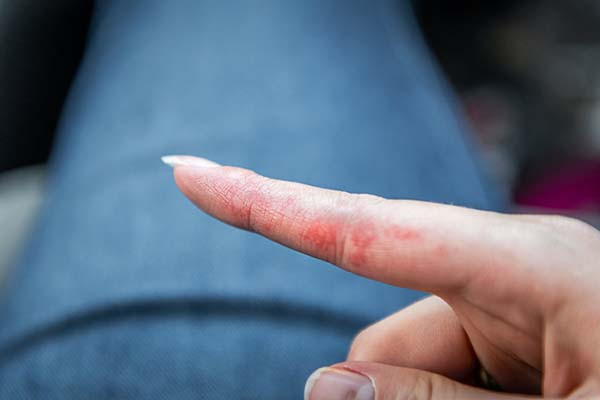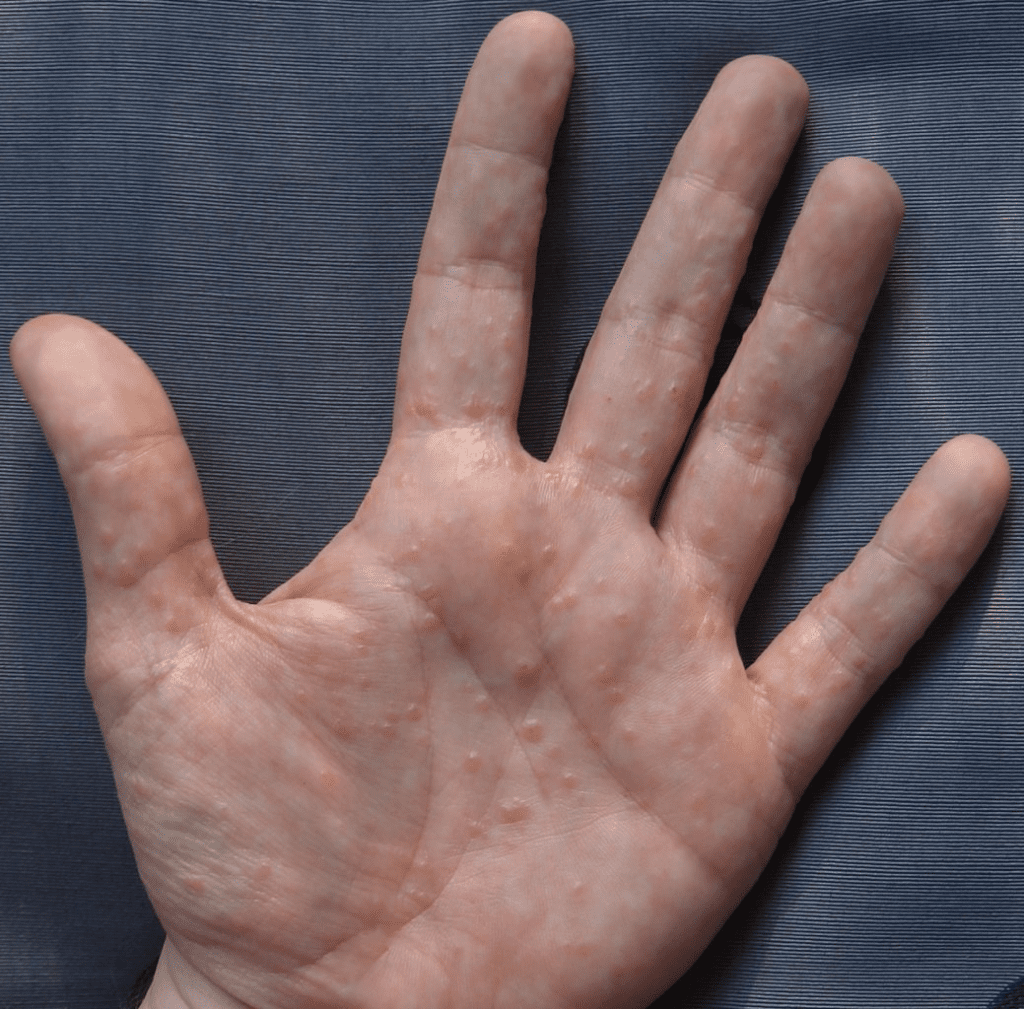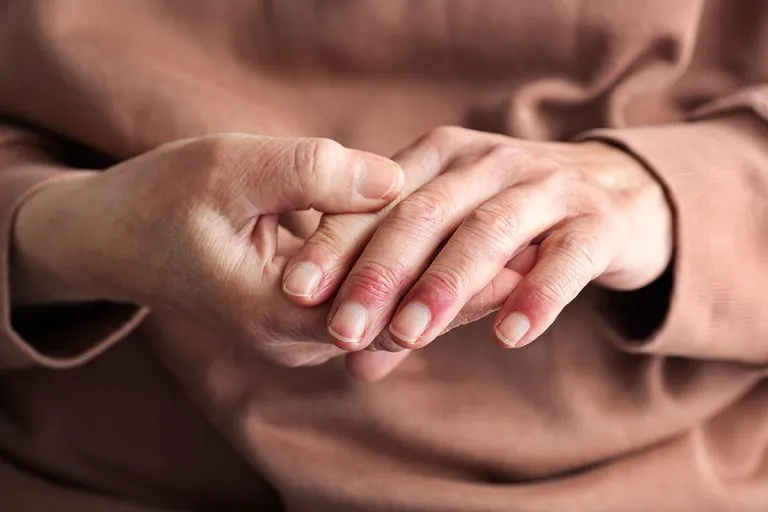Dyshidrotic eczema, also known as dyshidrosis or palmoplantar eczema, is a skin condition characterized by the development of small, itchy blisters on the soles of the feet, palms, or fingers. These blisters can sometimes grow larger, merge together, and cause considerable discomfort. While the condition can be frustrating to deal with, it’s manageable with the right approach. Let’s dive into what causes dyshidrotic eczema, how it manifests, and what treatments are available to relieve symptoms.

What Is Dyshidrotic Eczema?
Dyshidrotic eczema is a form of eczema that causes blisters on the hands and feet, often leading to intense itching and irritation. The blisters can last for 2 to 4 weeks, after which they typically heal on their own, though the skin may become dry or peel as the blisters subside. The condition may recur if the underlying triggers are not addressed.
Commonly, the blisters are filled with a clear fluid, and they can cause redness, swelling, and cracking in the affected areas. While dyshidrotic eczema is not contagious, it can be painful, particularly when the skin becomes infected from excessive scratching.
Causes of Dyshidrotic Eczema: Triggers to Be Aware Of
Although the exact cause of dyshidrotic eczema remains unclear, several triggers have been identified as contributing factors. These include:
- Sweating: Sweating can exacerbate symptoms, though researchers are unsure why it triggers the blisters.
- Allergies: People who are sensitive to certain metals like cobalt or nickel may develop blisters after exposure.
- Personal Care Products: Soaps, moisturizers, or other personal care products containing irritants can trigger a flare-up.
- Medications: Certain drugs, such as birth control or aspirin, may cause reactions in some individuals.
- Smoking: Tobacco smoke is another potential trigger.
- Stress: High levels of stress can trigger or worsen dyshidrotic eczema flare-ups.
- Weather Changes: Shifts in temperature or humidity may aggravate symptoms.
It’s worth noting that people with a family history of eczema or allergies, as well as those who work with cement or metal, are at higher risk of developing dyshidrotic eczema.
Symptoms of Dyshidrotic Eczema: Recognizing the Signs
Symptoms of dyshidrotic eczema often start with a burning or itching sensation on the palms, fingers, or soles of the feet. This uncomfortable feeling is usually the precursor to the formation of tiny blisters. These symptoms can appear suddenly, and the blisters themselves are typically:
- Itchy and filled with fluid
- Found on the palms of the hands, sides of fingers, or soles of the feet
- Small but capable of merging together into larger patches
As the blisters heal, the skin may become dry and begin to peel. People with darker skin tones may also notice hyperpigmentation—dark spots on the skin—once the blisters have healed.
In severe cases, the blisters can become infected, causing pain and swelling. If the blisters ooze pus, it’s essential to consult a doctor to prevent further complications.
Diagnosing Dyshidrotic Eczema: When to See a Doctor

If you notice inflamed, itchy skin on your hands or feet that persists for more than a week, it’s a good idea to visit a dermatologist. Diagnosis usually involves a physical examination of the skin, but doctors may also ask a series of questions to identify potential triggers, such as:
- Have you recently used any new personal care products?
- Do you work with metals or other irritants?
- Do you have a history of eczema or allergies?
In some cases, doctors may perform an allergy test or take a skin sample to rule out infection if the blisters do not heal properly.
Home Remedies for Managing Mild Flare-Ups
For mild cases of dyshidrotic eczema, there are several home remedies that may help relieve symptoms:
- Cool Compresses: Apply a cool, damp cloth to the affected area for 15 minutes, two to four times a day.
- Moisturize Regularly: Use a moisturizer or barrier repair cream on damp skin to lock in moisture and prevent the skin from drying out.
- Corticosteroid Creams: Over-the-counter corticosteroid creams can help reduce inflammation and heal blisters.
- Anti-Itch Medication: Pills or creams containing anti-itch ingredients can help manage discomfort.
- Stress Management: Techniques such as meditation or deep breathing can help minimize stress, a known trigger of dyshidrotic eczema.
Additionally, it’s important to avoid scratching the blisters, as this can lead to infection and delay healing.

Dietary Considerations: Nickel and Cobalt Allergies
If your dyshidrotic eczema is triggered by an allergy to nickel or cobalt, your doctor may recommend dietary changes. Nickel and cobalt are present in several foods, including:
- Cereals
- Dried fruit
- Tea
- Chocolate
- Soy products
- Legumes
- Dairy products, fish, poultry, and meat (for cobalt)
Since these foods are also valuable sources of essential nutrients, it’s crucial to work with a healthcare professional to create a balanced diet that limits exposure to these metals while maintaining proper nutrition.
Medical Treatment Options for Severe Symptoms
For more severe or frequent symptoms, medical treatments may be necessary. Doctors may prescribe:
- Stronger corticosteroid creams to reduce inflammation and heal blisters
- Pimecrolimus cream or tacrolimus ointment, which are non-steroidal treatments
- Systemic medications that suppress the immune system to prevent flare-ups
- Light therapy at a doctor’s office to help manage symptoms, though avoiding UV exposure is advised
Managing stress and ensuring plenty of rest are also important for recovery, as flare-ups are often linked to emotional or physical stress.

Complications and Long-Term Effects of Dyshidrotic Eczema
While dyshidrotic eczema is typically not life-threatening, it can have a significant impact on a person’s quality of life. The blisters can make everyday activities—such as walking, using your hands, or even sleeping—challenging. Additionally, the itching and discomfort may cause people to scratch the blisters, which can lead to infection or scarring.
Prevention Strategies: How to Reduce the Risk of Flare-Ups
Although it’s not always possible to prevent dyshidrotic eczema, there are several strategies to minimize flare-ups:
- Identify and avoid triggers by keeping a journal of potential allergens or irritants.
- Wear protective gloves when handling detergents or chemicals.
- Use dye-free cotton socks and footwear made from natural materials.
- Moisturize frequently to keep skin hydrated and prevent cracking.
- Manage stress through relaxation techniques like yoga or mindfulness.
Working with a dermatologist on a personalized prevention plan can also help reduce the frequency and severity of symptoms.

Conclusion: Managing Dyshidrotic Eczema Effectively
Dyshidrotic eczema can be a frustrating and uncomfortable condition, but with proper care and management, flare-ups can be controlled. Whether through home remedies, medical treatments, or lifestyle changes, it’s possible to live comfortably with this form of eczema. By understanding potential triggers, seeking timely treatment, and preventing complications, individuals with dyshidrotic eczema can improve their quality of life while reducing the impact of this skin condition.


